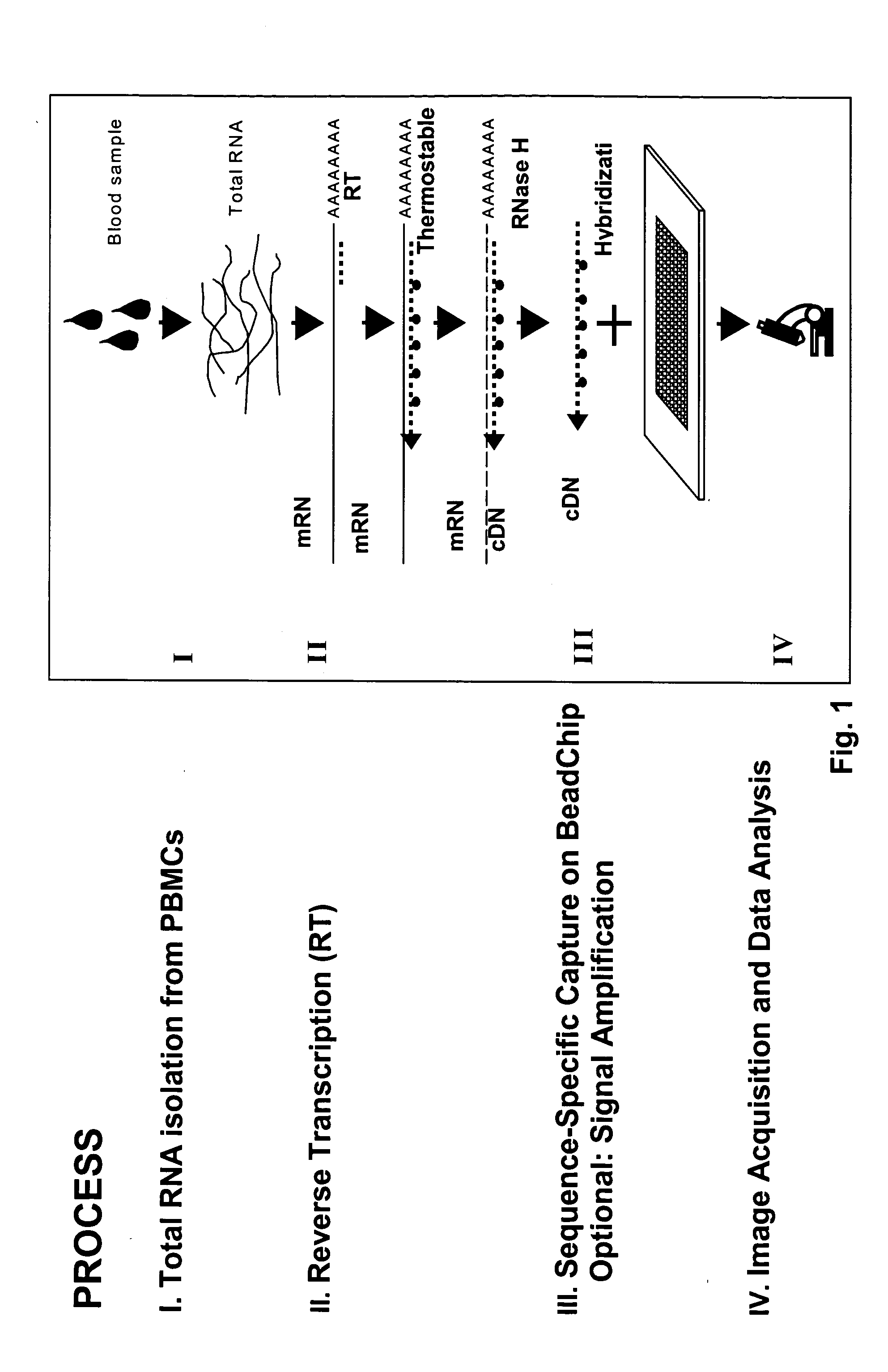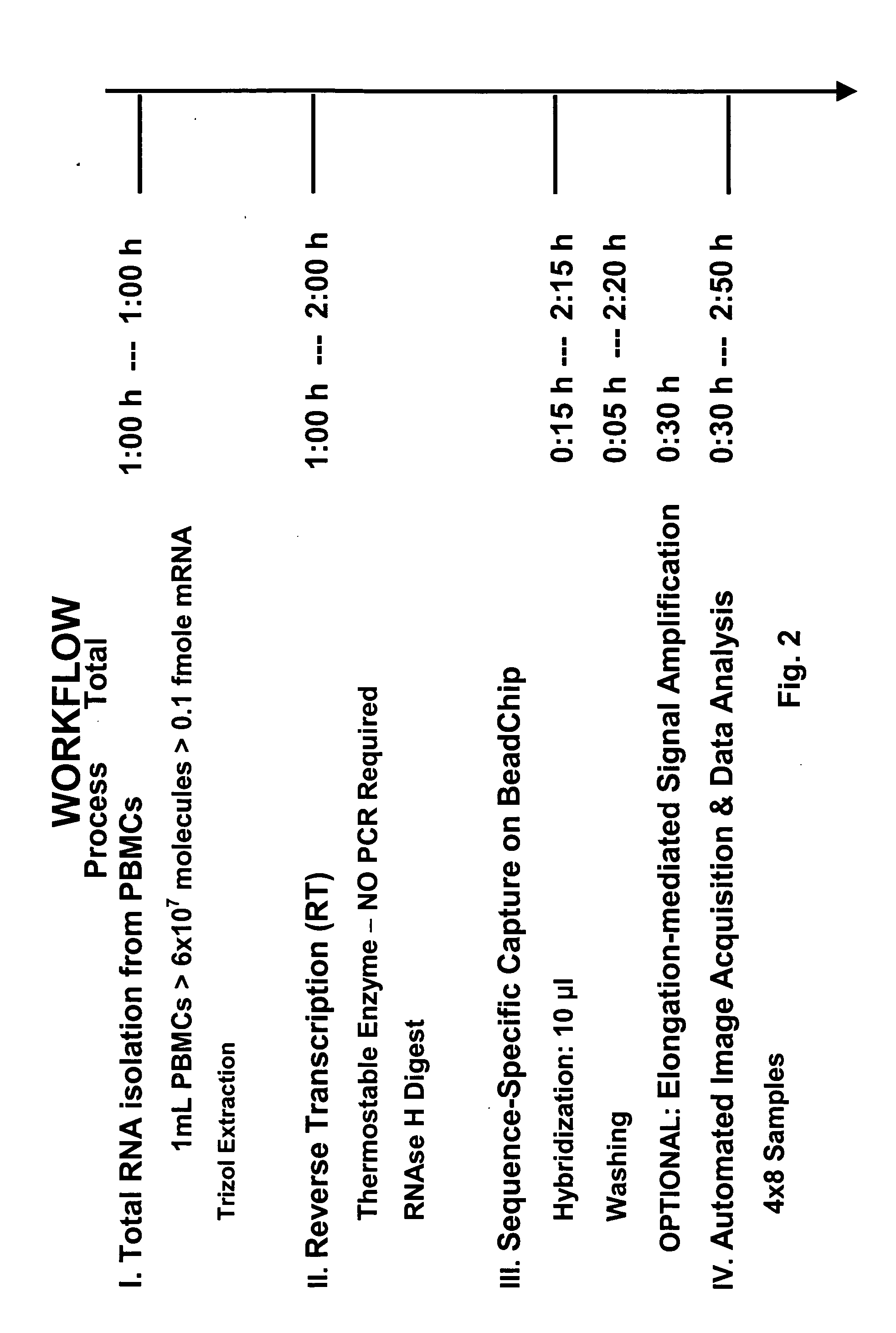Optimization of gene expression analysis using immobilized capture probes
- Summary
- Abstract
- Description
- Claims
- Application Information
AI Technical Summary
Benefits of technology
Problems solved by technology
Method used
Image
Examples
example i
Effect of Probe and Transcript Length on Capture Efficiency
[0232] Synthetic DNA polynucleotide targets varying in length from 25-mers to 175-mers, were synthesized (by IDT, Madison, Wis.), and each of the larger targets contained the smaller target as an interior subsequence. All the targets were labeled with Cy5 fluorescent label at the 5′ end. Amine-modified (5′ end) oligonucleotide probes, varying in length from 15 nt to 35 nt, were also synthesized (IDT, Madison, Wis.). The detailed sequence information is shown in Table I-1.
[0233] The probes were covalently linked to encoded tosylated microparticles using an EDAC reaction, as is well known in the art. A precalculated amount of each of the synthetic targets was taken from a 10 μM stock solution of the target in de-ionized water, and was diluted with 1×TMAC (4.5 M tetramethyl ammonium chloride, 75 mM Tris pH 8.0, 3 mM EDTA, 0.15% SDS) to a desired final concentration. One or more of the probe types listed in Table I-1 were func...
example ii
Determination of the Absolute Number of Fluorophores Present per Particle
[0234] Experiments were performed with commercially available QuantiBRITE™PE Phycoerythrin Fluorescence Quantitation kit from Becton-Dickinson, Franklin Lakes, N.J. The kit consists of 6.6 μm polymer beads, conjugated with known number of Phycoerythrin (PE) molecules on the surface. For quantitative analysis of the fluorescent intensity associated with the beads, random planar arrays of the beads were assembled on the surface of a silicon wafer. The fluorescent intensity from the PE fluorophores on the particle surface was then monitored as a function of varying number of surface conjugated PE fluorophores (data supplied by manufacturer) using a standard fluorescent microscope fitted with an appropriate fluorescence filter and a CCD camera. In this study, a Nikon Eclipse E-600FN epifluorescence microscope equipped with 150 W xenon-arc lamp was used for measurements. A Nikon 20×0.75 NA air objective, and a R&B ...
example iii
Generic Protocolfor Rapid Expression Monitoring
[0238] A typical experimental protocol for multiplexed expression monitoring is as follows. A protocol establishing optimized conditions in accordance with the methods of the present invention is described below. The entire protocol including signal amplification in accordance with the methods of the present invention is completed in less than three hours (see FIGS. 1 and 2).
[0239] Step 1—Total RNA is isolated from a blood or tissue sample using Qiagen silica-gel-membrane technology. DNA oligonucleotides with a sequence complementary to that of mRNAs of interest are added to the preparation to prime the reverse transcription of the targeted mRNAs into cDNAs.
[0240] Step 2—The solution containing mRNAs is heated to 65° C., typically for a period of 5 minutes, to facilitate annealing of primers to denatured mRNAs, following which the solution is gradually cooled to room temperature at a typical rate of 2° C. / min. Reverse transcriptase (...
PUM
| Property | Measurement | Unit |
|---|---|---|
| Molar density | aaaaa | aaaaa |
| Length | aaaaa | aaaaa |
| Concentration | aaaaa | aaaaa |
Abstract
Description
Claims
Application Information
 Login to View More
Login to View More - R&D
- Intellectual Property
- Life Sciences
- Materials
- Tech Scout
- Unparalleled Data Quality
- Higher Quality Content
- 60% Fewer Hallucinations
Browse by: Latest US Patents, China's latest patents, Technical Efficacy Thesaurus, Application Domain, Technology Topic, Popular Technical Reports.
© 2025 PatSnap. All rights reserved.Legal|Privacy policy|Modern Slavery Act Transparency Statement|Sitemap|About US| Contact US: help@patsnap.com



